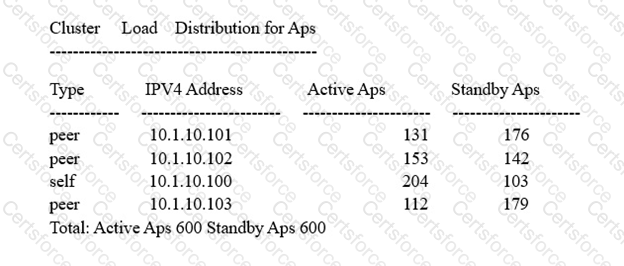An administrator supports a RAP to a branch office. Employees at the branch office connect to an employee SSID that allows for split tunneling of the employee traffic. The RAP initially connects to the corporate office controller, but later loses connectivity to it.
Which operating mode should the administrator configure for a secondary SSID to be advertised during the loss of connectivity?
Refer to the exhibit.

An administrator sets up a cluster of Aruba Mobility Controllers (MCs). What can the administrator determine about the cluster from the command output shown in the exhibit?
An administrator configures a port on a RAP through the association of an AAA profile with 802.1X authentication to a RAP Ethernet port. This port connects to a switch with user desktops attached. The administrator notices that when users connect wirelessly to the RAP, a user role correctly restricts their traffic. But, when users connect with their wired desktops, they have full access to corporate resources.
What must the administrator do to restrict desktop usage based on the users’ role assignment?
An administrator implements the MultiZone feature and uses two clusters that utilize CPSec. A primary and a data zone are created. MultiZone APs successfully build sessions to the primary cluster but fail to establish sessions to the data zone cluster.
What must the administrator do to solve this problem?
An administrator sets up a network scan set in AirWave to scan a subnet to identify devices for a firmware upgrade. The scan completes and AirWave successfully uses the SNMP credentials to validate SNMP access. However, SSH access fails and the administrator must manually configure the SSH credentials used for all of these devices.
What should the administrator have done before running the network scan?
An administrator creates a cluster of four Mobility Controllers (MCs). When the administrator verifies the cluster operation, the administrator notices that it is operating as an L3-connected cluster.
What should the administrator do to ensure that the cluster operates as an L2-connected cluster? (Choose two.)
Which IEEE standard should user devices support to implement Fast BSS Transition when a network implements wireless roaming (mobility)?
An administrator enables AP load balancing for a cluster of Mobility Controllers (MCs). APs connected to the cluster have an LMS IP address configured in their AP Group configuration. No other parameters are changed in the cluster.
If the two load AP thresholds are reached, what occurs?
An administrator needs to modify a VAP used for a branch office RAP. The VAP’s operating mode is currently defined as backup and uses tunnel mode forwarding. The administrator wants to implement split-tunnel forwarding mode in the VAP.
Which WLAN operating mode must the administrator define for the VAP before the tunnel forwarding mode can be changed to split-tunnel?
An administrator manages an Aruba wireless network. Users authenticate to the wireless network using PEAP, where their credentials are validated by the controller’s local database. The company purchases Android tablets to use with an inventory tracking system. The administrator notices that many of the users of these devices use their normal username and password to authenticate, which allows the tablet to access all resources that the user can access from their wireless computers. This is a security violation.
Which Aruba Mobility Controller (MC) feature should the administrator configure to restrict tablet access to a web portal for authentication, where an appropriate post-authentication policy can be applied to these tablets?